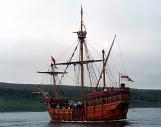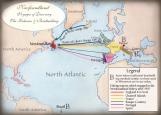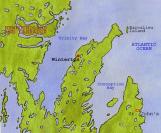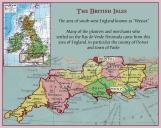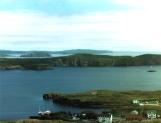2
Some Newfoundland boat building traditions may have crossed the Atlantic following John Cabot's voyage of discovery. This voyage was sponsored by Henry VII and Cabot officially claimed the island for England in 1497. He sailed from the west-country port of Bristol, England. Many Newfoundland settlers came from this area of southwest England known as Wessex. It is quite possible that fishermen from Europe already had some knowledge of Newfoundland through the Norse sagas. Fishermen from France, Spain, Portugal, the Basque country and England were venturing far out into the Atlantic Ocean and returning with fine catches during the 15th century.Cabot's vessel, the Matthew, a 15th century sailing ship was named after Cabot's wife Mathieu, and was a Portuguese Caravel, a word which refers to carvel planking, a type of planking still used in Winterton today.
"Matthew represents the last period when important ships were designed and built by the builders without any outside design intervention by naval architects." Colin Mudie (Builder of the Matthew)
4
The fifteenth century was the beginning of an age of exploration. The development of astronomy and better instruments for navigation allowed ships to sail safely out of the sight of land. Also, all of the great exploring and fishing nations had the naval architectural skills to build strong, seaworthy ships and fishing boats. It may be that the very old boat building techniques still used in Winterton today were commonly used throughout Western Europe all those years ago. Today these techniques are used in very few places: Newfoundland, Greece, Portugal, Venice (in the building of gondolas) and Brazil, where the knowledge was perhaps brought by the Portuguese.The fishermen who first came to Newfoundland following Cabot's voyage were part of a migratory fishery. In the spring of the year, ships carried men and smaller boats to Newfoundland where the fishermen would catch and cure codfish over the summer months and return to Europe with their product in the fall. Although the small inshore fishing boats were transported to Newfoundland, men with boat building skills must have been required to make repairs and perhaps replace boats lost or smashed beyond repair during the fishing season.
One record of what seems to be a boat building station is mentioned in John Guy's letter to Master Slaney, treasurer, and to the Counsel of the Newfoundland plantation, May 16,1611, as quoted by Prowse:
"...and a work house to work dry in; to make boats or any other work out of the raine...A boat about twelve tons big, with a deck, is almost finished to saile and row about the headlands: six fishing boates and pinnesses:..."
John Guy established the first official English settlement in what is now Canada. This settlement was at Cuper's Cove, Conception Bay, Newfoundland.
6
The Bay de Verde Peninsula, where Winterton is located, was an early fishing site for many migratory fishermen. The waters around Baccalieu Island were particularly favored fishing grounds.When they arrived at Baccalieu, the fishermen set up their summer fishing stations on both sides of the peninsula in Conception Bay and Trinity Bay. The fishing boats that were transported across the Atlantic were gradually changed and adapted to suit the particular water conditions found around Baccalieu Island and the waters of the Trinity and Conception Bays. At the same time the properties of the local timber were being explored.
Baccalieu Island is now a bird sanctuary, the home of the largest colony of Leach's Storm Petrels in the world. This island with its high cliffs and rocky terrain appears on all the early maps as it was a landfall for migratory fishermen. The sea birds wheeling high above the island could be spotted long before the land was visible and the ships would steer in that direction. The attraction for both the birds and the fishermen was that the waters around the island were teeming with fish.
Winterton fishermen were still fishing off Baccalieu Island well into the 20th century. The boats that they built for the choppy waters in the area were different from those used for the fishing grounds just off Winterton.
8
Gradually settlement took place as more and more people from the British Isles over-wintered and settled permanently in Newfoundland. In 1675, three planters (settlers) made Scilly Cove (Winterton) their home: John Petten, James Weeksell and Richard Hopkins. Six years later there were three more planters, Sam Waxill, John Pollinson and Anthony Butt.Anglo-French wars in Europe were extended to the new world. When the French Canadians, led by D'Iberville, raided the area in 1696 most of the settlers fled into the woods. Several were killed and John Masters, a planter, was roused from his bed, his house was looted and he and his goods were taken northward on a Jersey ship. He escaped and took his wife, son, and four daughters, the youngest only eight months old, back to Poole, Dorset. He bought a "low old house" on high street and settled there. To make ends meet, his wife operated an ale house, The Old Red Cow.
John Masters returned to Scilly Cove in 1698 and eleven years later is said to have been murdered by Natives. French raids continued until 1713 when the Treaty of Utrecht brought an end to Anglo-French hostilities in Europe.
It is through these connections with Europe that boat building knowledge was likely transferred from the old country to Newfoundland. These traditional methods would have then been adjusted over time to suit the conditions of the ocean and local timber found around the Scilly Cove settlement.
10
In the area of Trinity Bay where Winterton is located, fishermen, planters, servants (workers), and merchants mostly came from southwest England, in particular the area around Poole, Dorset. Poole's wealth in the seventeenth and eighteenth centuries depended upon the fish that was caught, dried and salted in Newfoundland and then shipped to markets mainly in the Mediterranean countries. At the end of the fishing season most of the fishermen returned to England. The profits accrued to the Poole merchants and over time firms established year-round premises in Trinity Bay. Several weeks were needed at the start of each fishing season to build flakes and repair stores and equipment. If this work was done by over-wintering workers, fishing could start almost immediately. Workers who stayed on the island could also protect their property from the Natives.Fishermen did not market their own fish, they had to depend on merchants who outfitted them and took their catch in payment for supplies. The fishermen of Scilly Cove (Winterton) in the seventeen hundreds traded their fish with Joseph White and Sons of Bay de Verde, Old Perlican and Poole. After the French raids of 1696 this firm moved to a safer location in Trinity. Scilly Cove became a fishing station for the merchants of Poole and Trinity.
11
This house belonged first to the Lesters and later to the Garlands, merchants of Trinity and Poole.1990
Trinity, Newfoundland, Canada
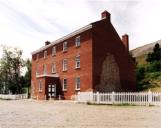
12
John Jeffery and Thomas Street (who owned the firm called Jeffery and Street) The Whites, the Lesters, and Garlands were Poole merchants who had establishments in Trinity. From around 1700 onwards Scilly Cove (Winterton) was a satellite operation for these firms that had agents and premises there. These were occupied by Robert Galpin and Ann Macey in 1800. Also, at this time Benjamin Lester had 5 fishing rooms, 7 dwellings and 10 boats in Scilly Cove.The merchants recruited planters and servants from the Poole area. When the recruits arrived in Trinity, they were sent to the various satellite fishing stations around the bays. Scilly Cove was one of the more important stations. During the winter those servants who did not return to England after the summer fishery were employed cutting timber and repairing and building boats.
They came with their boat building tools and techniques and by 1800 Scilly Cove had developed a reputation as a centre for the construction of inshore fishing boats. There were never many larger boats such as schooners built here as cured fish was not shipped out to world markets from this point. Trinity was the centre from which dried fish was collected and shipped after 1700, and larger transatlantic ships began to be built there. The Poole connection diminished after the Napoleonic wars when the fish trade was prosecuted from Newfoundland by Newfoundlanders.
Sources
Trinity Historical Society Inc. Thanks to Jim Miller
based on work by Dr. Gordon Handcock
Dr. Otto Tucker President of the Wessex Society
